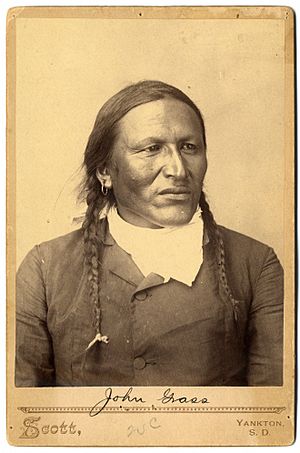John Grass facts for kids
Quick facts for kids Chief John Grass |
|
|---|---|
| Sihasapa band chief, Lakota | |

Matȟó Watȟákpe
|
|
| Born | 1836 |
| Died | May 10, 1918 (aged 82) Fort Yates, Sioux, North Dakota, USA |
| Spouse | Cecilia Walking Shield |
| Father | Used As A Shield Grass |
| Mother | Wawapilakiyewin Woman who does many Favors |
John Grass, also known as Matȟó Watȟákpe or Charging Bear, was an important leader of the Sihasapa (Blackfeet) band of the Lakota people. He lived from 1836 to May 10, 1918. He served as a chief during the late 1800s.
Chief John Grass was involved in several key events in Native American history. He fought in the famous Battle of the Little Bighorn in Montana. He also led his people in a significant battle against the Pawnee near the Republican River in Nebraska. This event is known as the Battle of Massacre Canyon.
Early Life and Education
John Grass was born in 1836 near the Grand River in South Dakota. In his younger years, he was known as Charging Bear. His father, Used as a Shield, and his grandfather, Sicola (Bare Foot), were both respected leaders of the Sihasapa people.
When he was three years old, John Grass was baptized by a Jesuit priest named Pierre-Jean De Smet. Later in 1867, he married Cecilia Walking Shield in a Lakota ceremony. They renewed their wedding vows in a Roman Catholic ceremony in 1894. John Grass had several children, though many passed away when they were young.
John Grass attended the Carlisle Indian Industrial School in Carlisle, Pennsylvania. There, he learned to read and speak English very well. This skill was very helpful. He used his knowledge of English to speak for his people when they talked with the United States government.
A Leader for His People
During the 1850s and 1860s, John Grass took part in battles against other tribes. He was a member of a group called the White Horse Riders Society.
From the late 1870s until he died, John Grass held an important position. He was the chief justice of the Court of Indian Offenses for the Standing Rock Agency in North Dakota. He worked with his friend, the Hunkpapa warrior Gall. Together, they believed that formal education and farming could help their tribe survive and thrive.
John Grass strongly opposed the US government's attempts to take more Lakota lands. In 1888, he led a large effort to resist the Pratt Commission. This commission wanted to divide the Great Sioux Reservation. However, the land was eventually sold in 1889 under the Crooks Commission.
The US government did not always keep its promises. In 1902, John Grass led a group to Washington, DC. Their goal was to tell the federal government about the Lakota people's complaints and concerns.
Legacy and Impact
John Grass led his warriors in the 1873 Battle of Massacre Canyon in Nebraska. In this battle, a group of Lakota warriors attacked a group of Pawnee who were hunting buffalo. This was one of the last big battles between Native American tribes in the United States.
A monument was built near the canyon to remember this event. It is a 35-foot tall granite stone. Carved on the monument is the face of John Grass. It is placed slightly higher and across from the carving of Ruling His Son's face, a Pawnee chief who was also at the battle.
During the time of the Ghost Dance movement and the Wounded Knee Massacre, John Grass spoke for peace with the United States. This choice did not always earn him the full respect of some Hunkpapa leaders. Chief White Bull once described Grass as "A good talker... not a thinker or a smart man... could always say yes but never no."
Death
John Grass passed away on May 10, 1918. He died at his home near Fort Yates, North Dakota, on the Standing Rock Indian Reservation.

